Abstract
Lead intoxication has been recognized as a clinical entity since ancient times. Hippocrates (370 B.C.) was probably the first person to associate lead with clinical symptoms, since when the harmful effects of lead on the body have been well documented. Early observations culminated in the brilliant monograph of Tanquerel des Planches (1839) in which the clinical aspects of the disease were completely outlined and most of the early signs of the disease were mentioned. So complete was this work that virtually nothing has been added to des Planches's observations since their publication.
The earliest reference to lead anaemia was made in 1831 by Laennec, who described thinness of the blood and pallor of the tissues in cases of lead poisoning at necropsy. The first direct evidence of the effect of lead on red blood cells was presented by Andral and Gavarret (1840), who counted the number of red blood cells in cases of lead poisoning and found the count to be much lower than normal.
Since these early reports a great deal of work has been undertaken to try to discover the means by which lead causes anaemia, but it is probably true to say that at the present time this mechanism is still not fully understood. This review is an attempt to draw together at least some of the theories which have been advanced in the past and to present them, it is hoped, in an easily accessible manner for future workers in this field.
Full text
PDF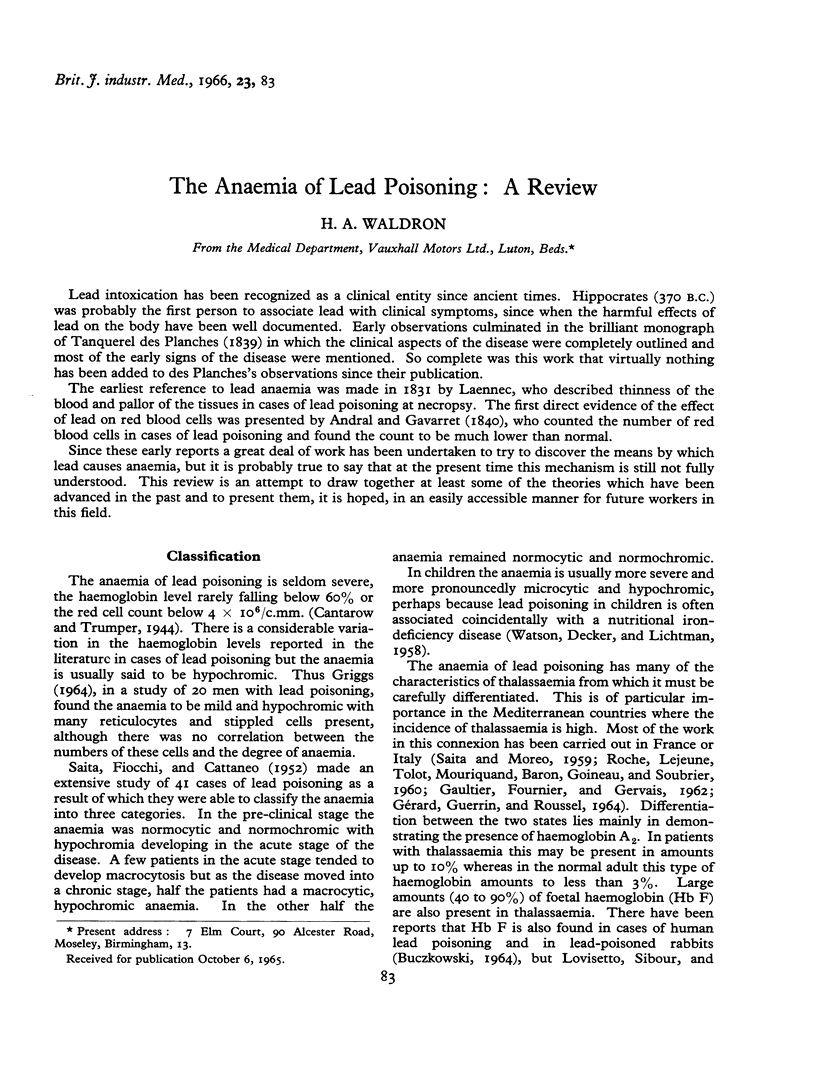
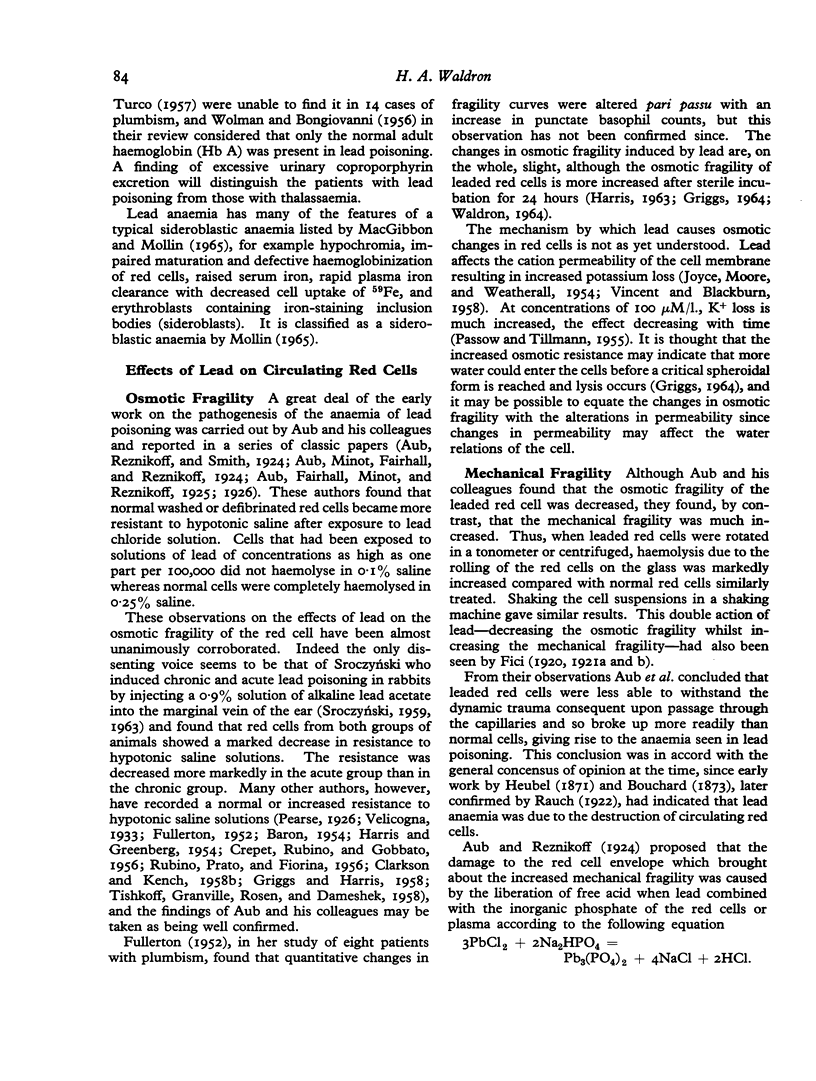
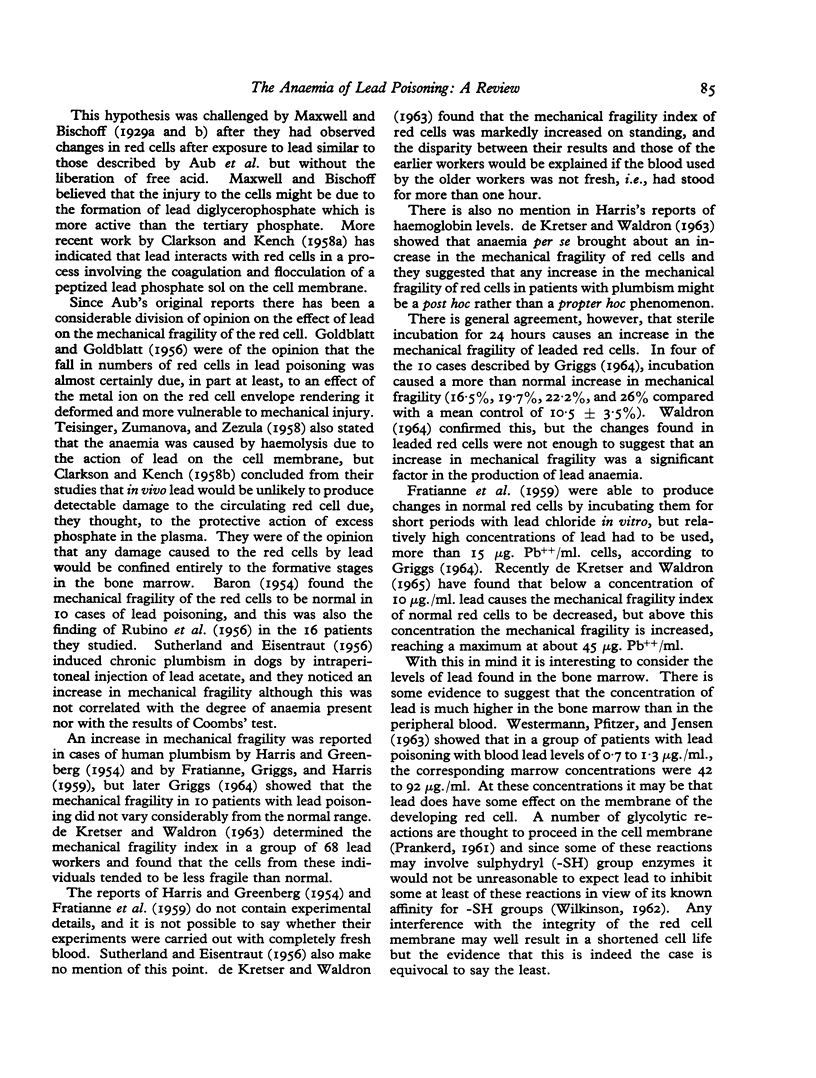
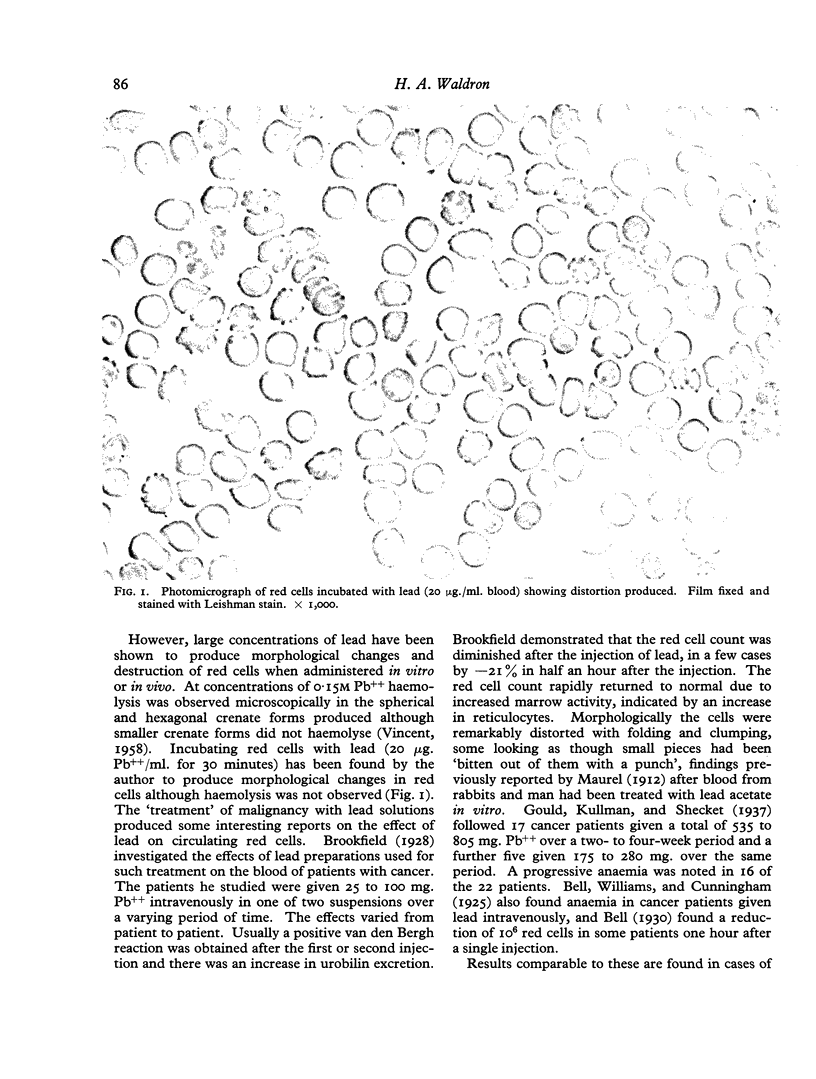
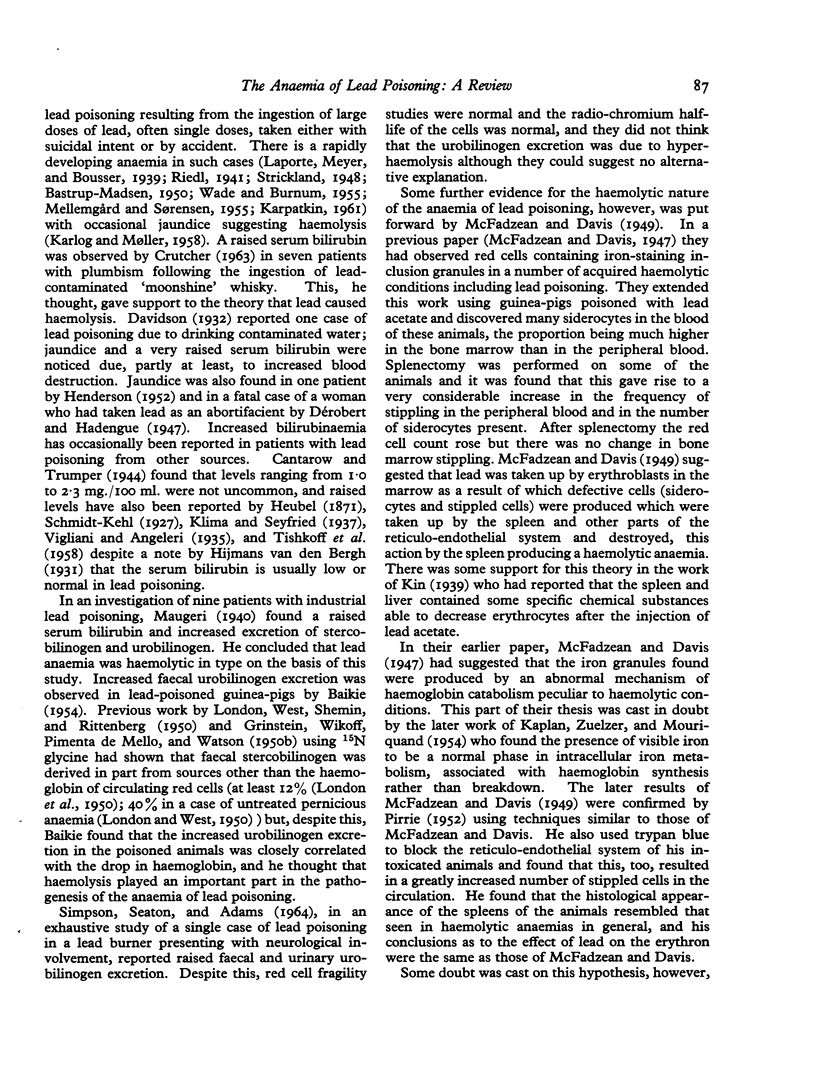
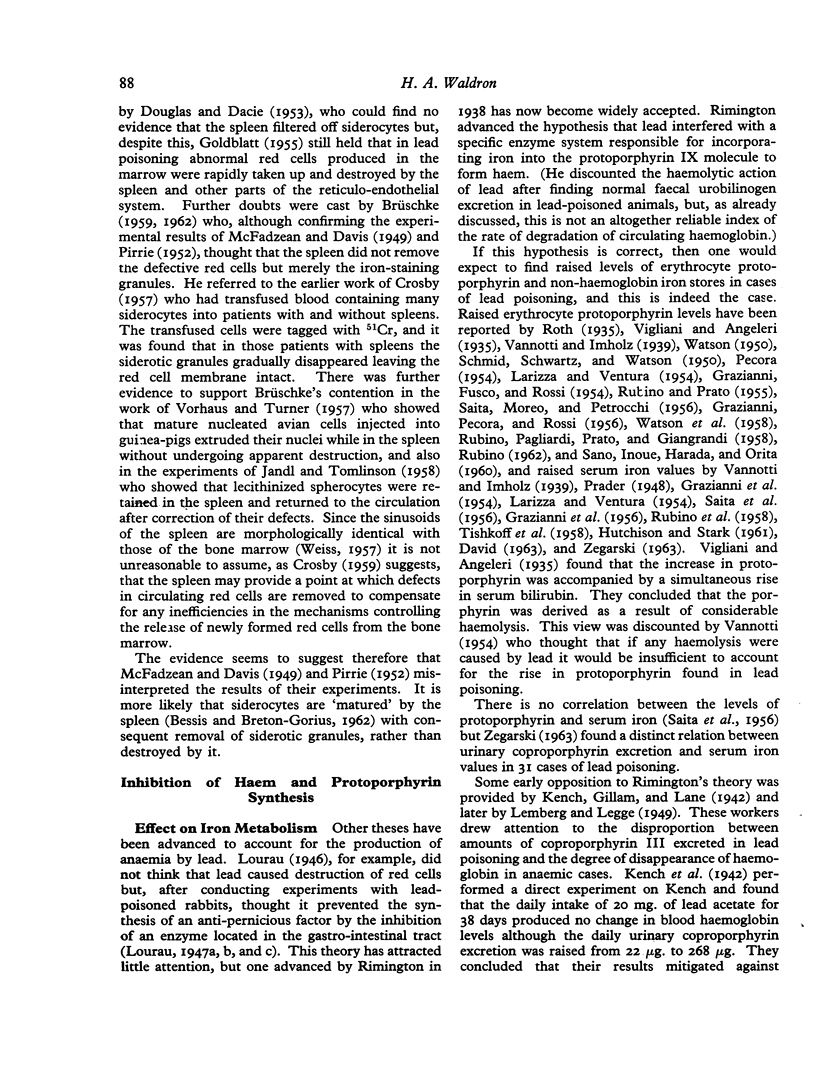
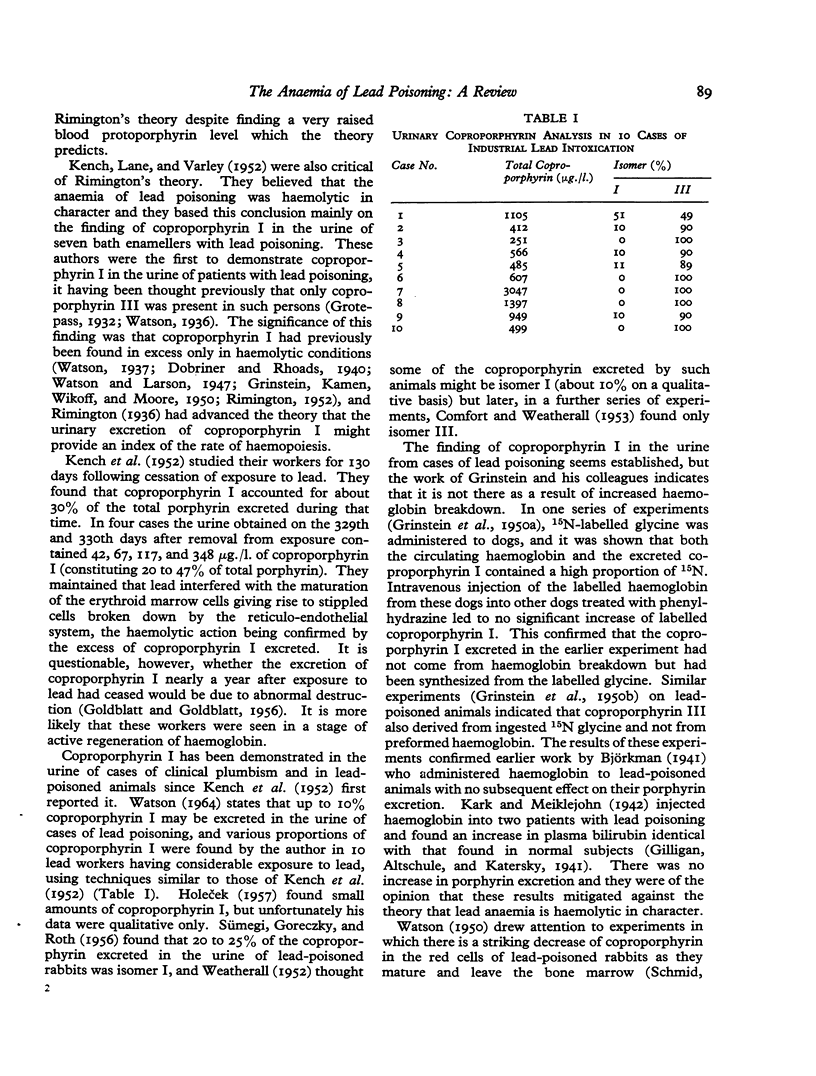
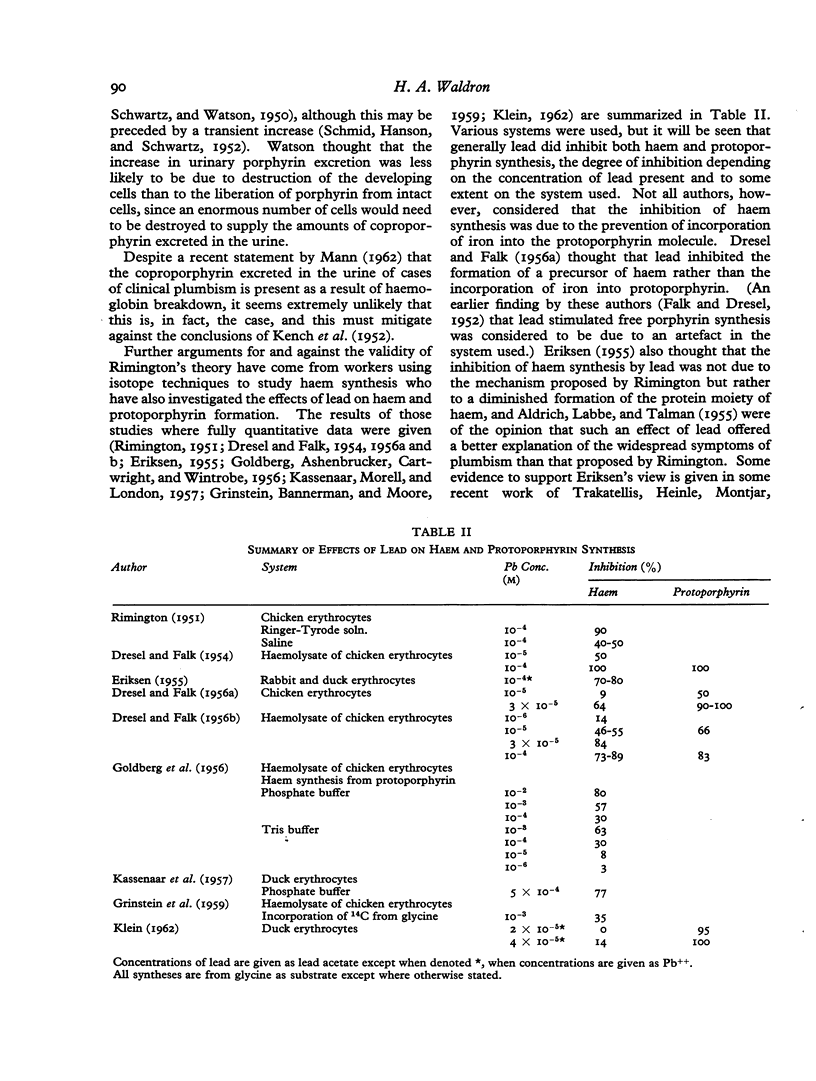
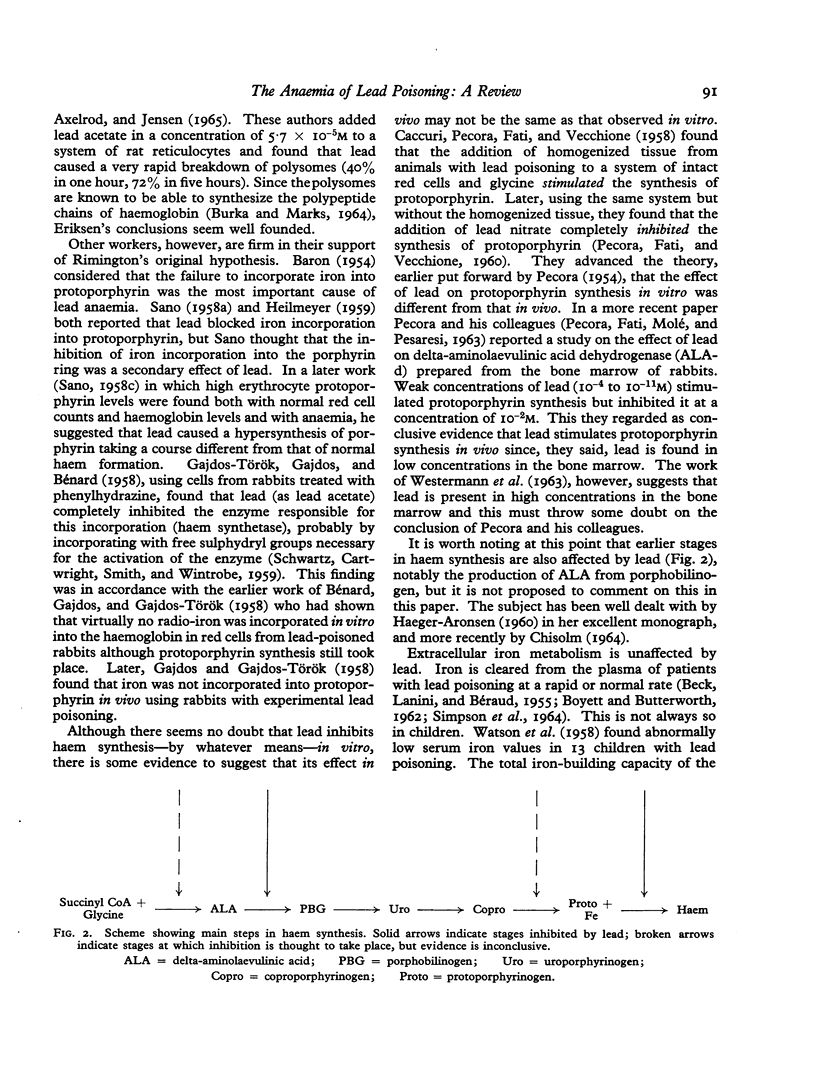

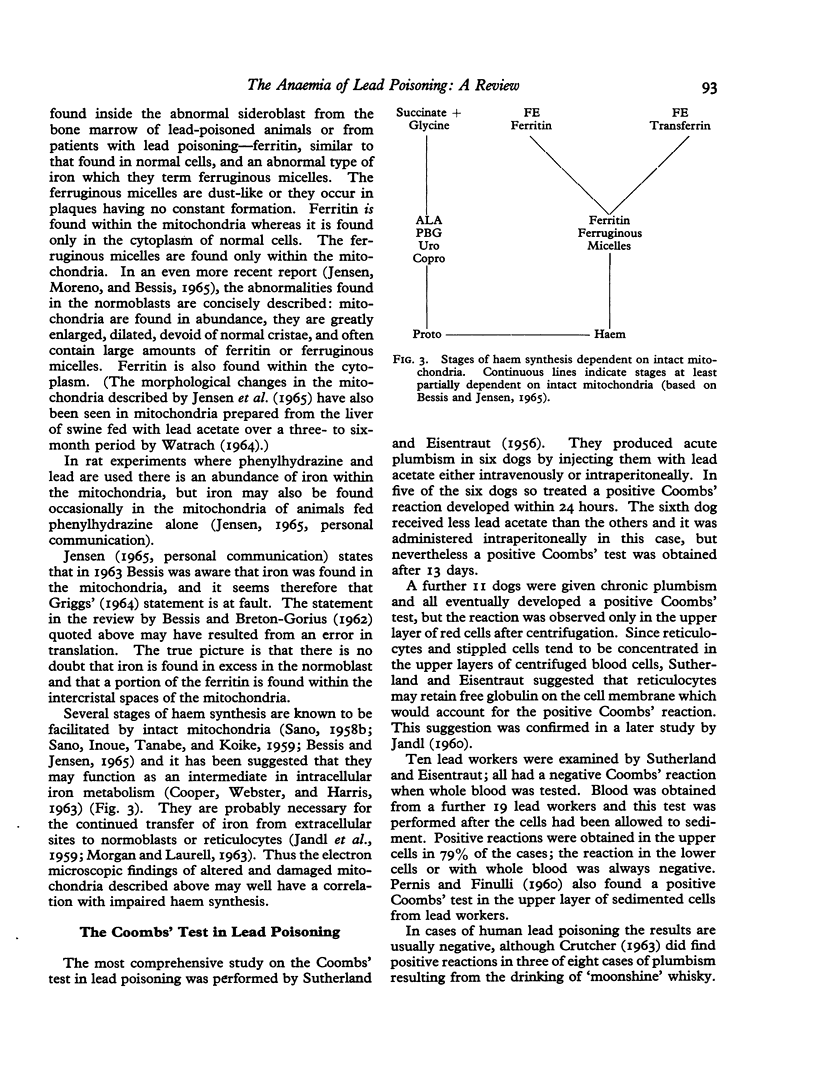
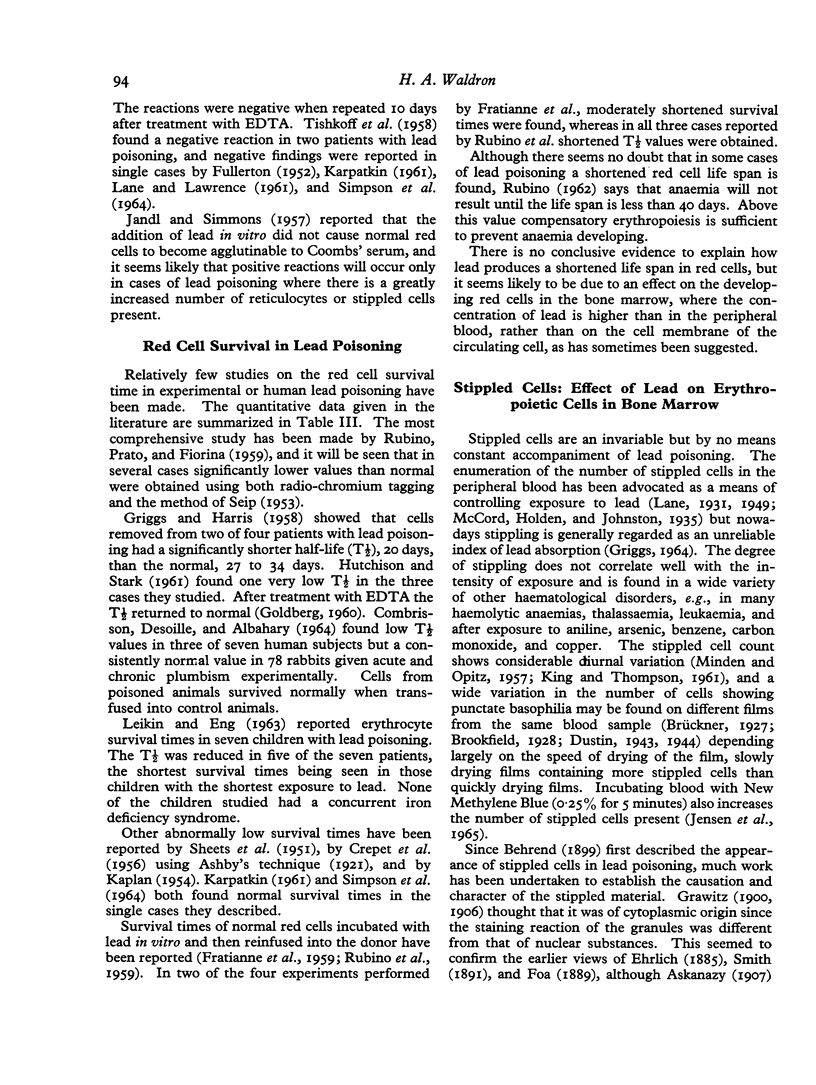
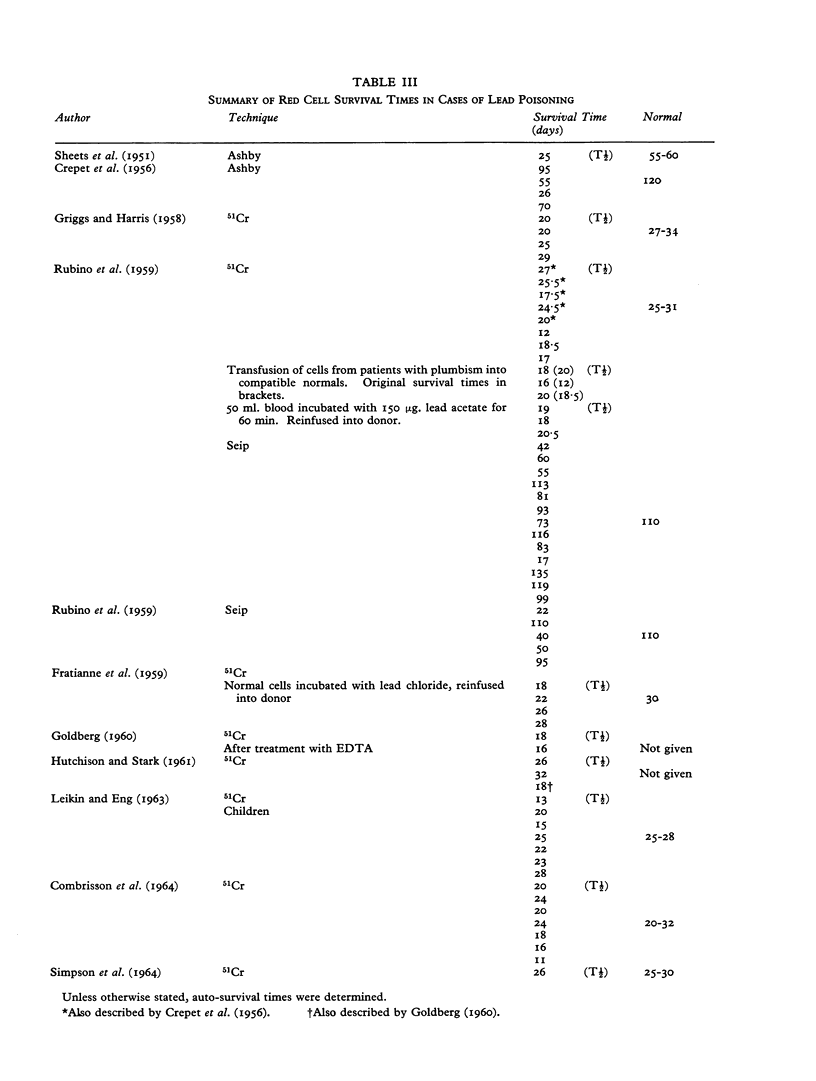
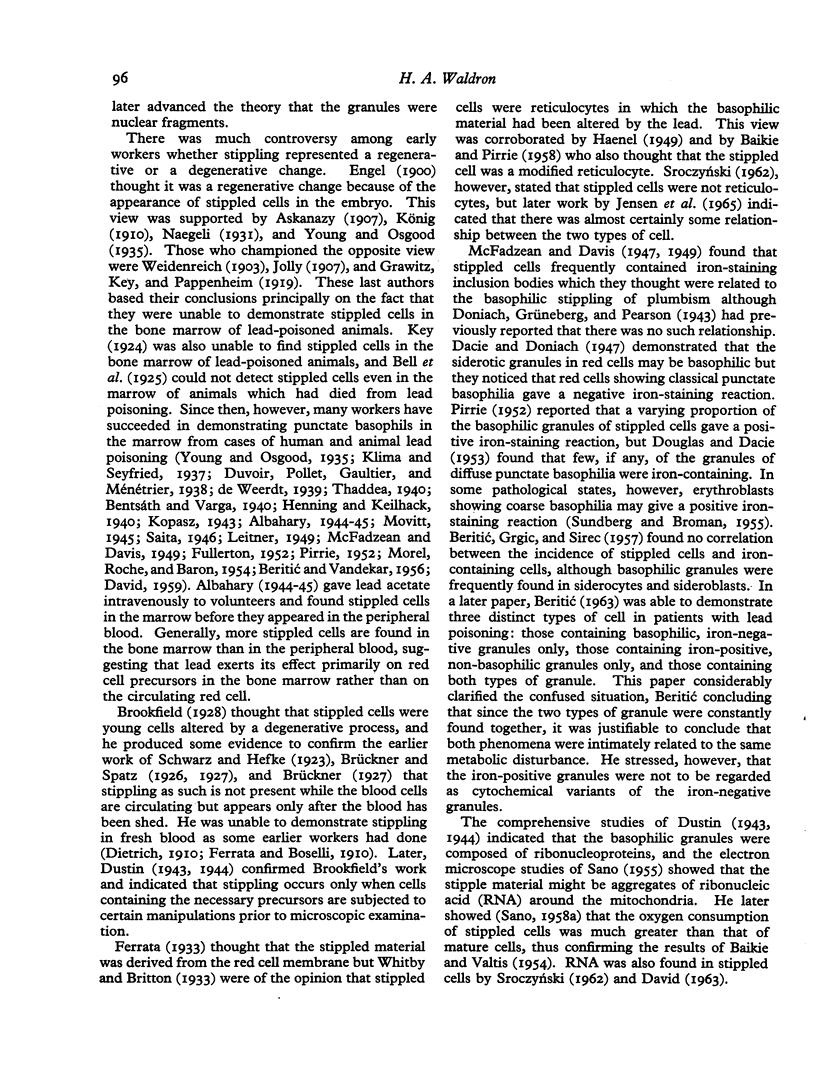
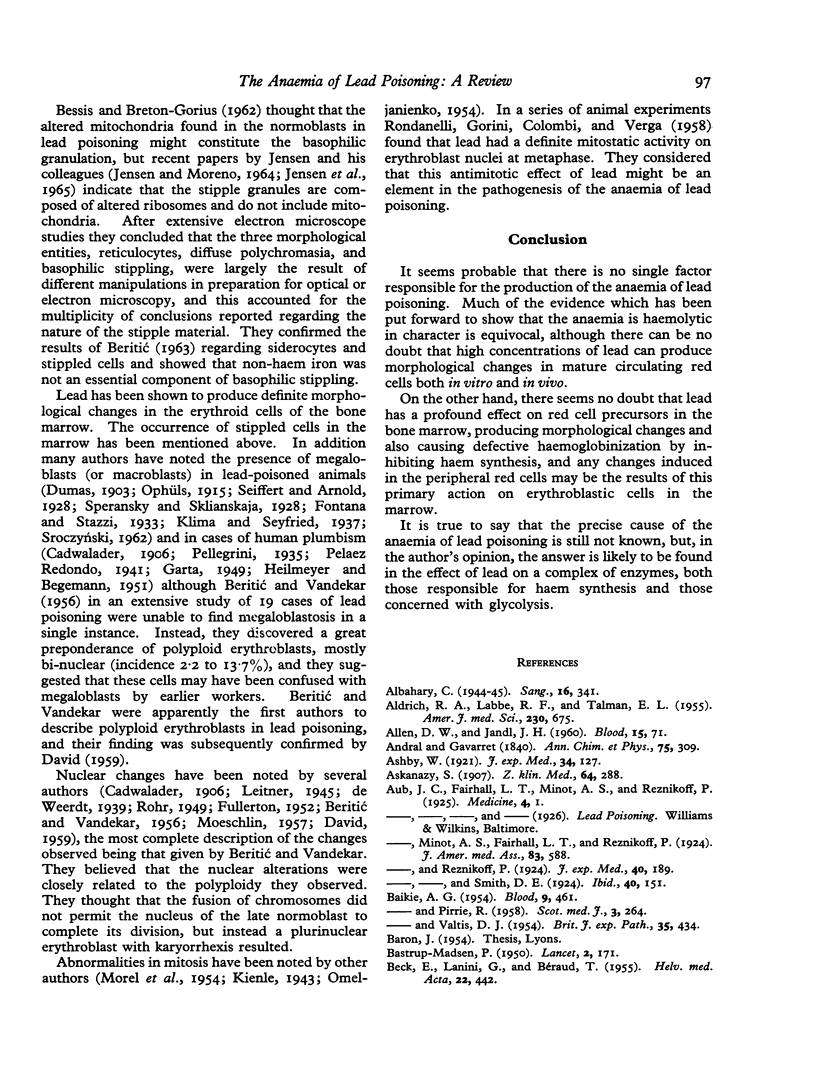
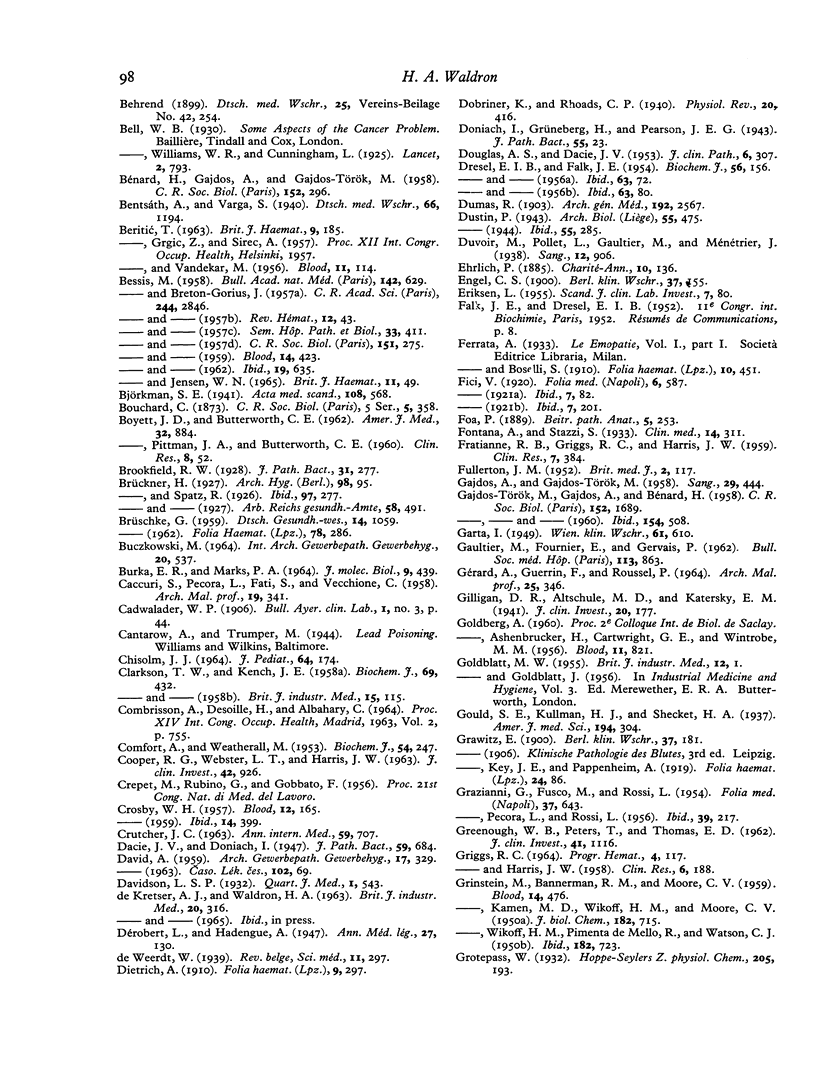
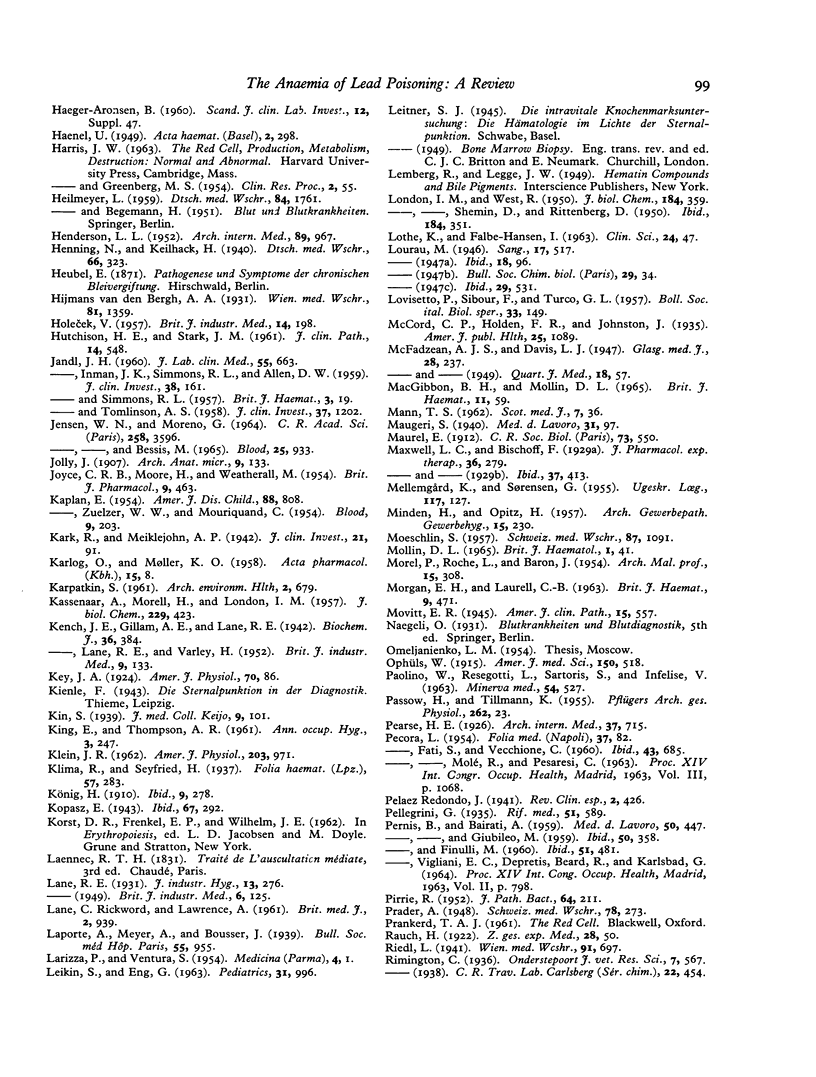
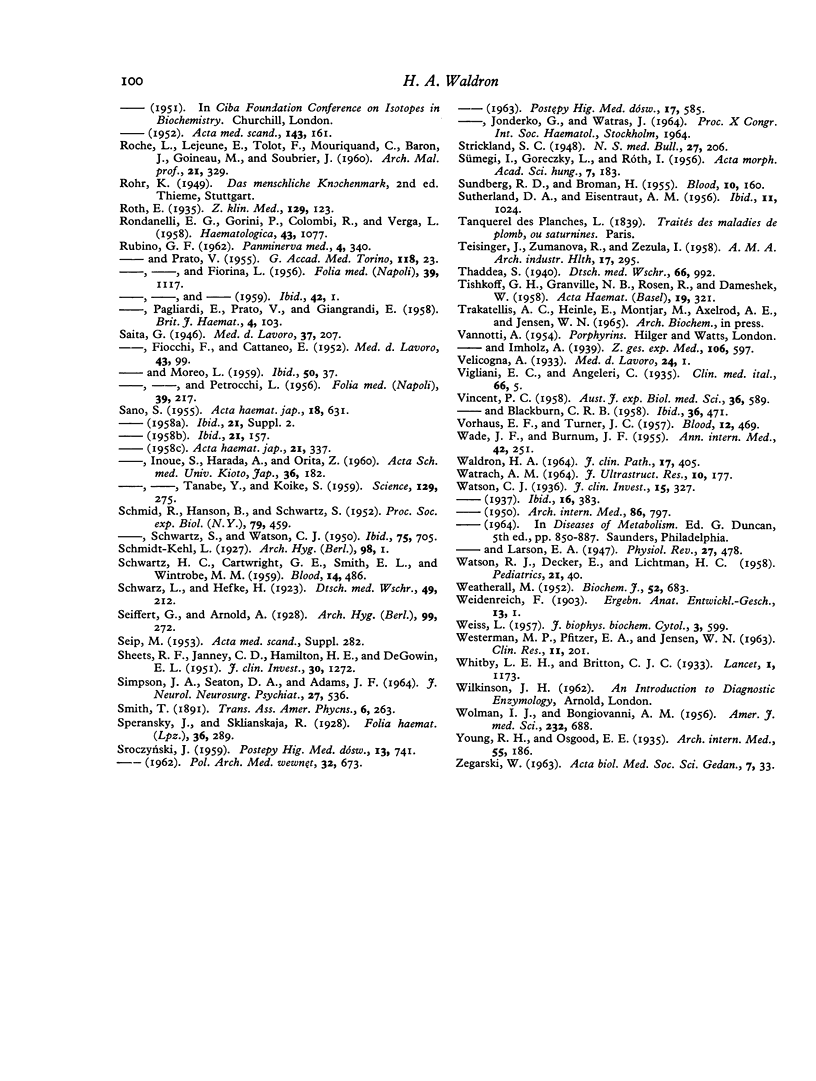
Images in this article
Selected References
These references are in PubMed. This may not be the complete list of references from this article.
- ALDRICH R. A., LABBE R. F., TALMAN E. L. A review of porphyrin metabolism with special reference to childhood. Am J Med Sci. 1955 Dec;230(6):675–697. doi: 10.1097/00000441-195523060-00010. [DOI] [PubMed] [Google Scholar]
- ALLEN D. W., JANDL J. H. Kinetics of intracellular iron in rabbit reticulocytes. Blood. 1960 Jan;15:71–81. [PubMed] [Google Scholar]
- ASHENBRUCKER H., CARTWRIGHT G. E., GOLDBERG A., WINTROBE M. M. Studies on the biosynthesis of heme in vitro by avian erythrocytes. Blood. 1956 Sep;11(9):821–833. [PubMed] [Google Scholar]
- BAIKIE A. G. The fecal excretion of urobilinogen of normal and lead poisoned guinea pigs. Blood. 1954 May;9(5):461–472. [PubMed] [Google Scholar]
- BAIKIE A. G., VALTIS D. J. The oxygen consumption of the blood in experimental lead poisoning. Br J Exp Pathol. 1954 Oct;35(5):434–438. [PMC free article] [PubMed] [Google Scholar]
- BASTRUP-MADSEN P. Dimercaprol in acute lead poisoning. Lancet. 1950 Jul 29;2(6622):171–172. doi: 10.1016/s0140-6736(50)91149-4. [DOI] [PubMed] [Google Scholar]
- BECK E., LANINI G., BERAUD T. Le mëtabolisme du fer dans l' intoxication au plomb. Helv Med Acta. 1955 Nov;22(4-5):442–445. [PubMed] [Google Scholar]
- BENARD H., GAJDOS A., GAJDOSTOROK M. Etude de la biosynthèse de l'hème in vitro à l'aide des isotopes radioactifs à partir du sang de lapin intoxiquè par le plomb. C R Seances Soc Biol Fil. 1958;152(2):296–299. [PubMed] [Google Scholar]
- BESSIS M., BRETON-GORIUS J. Accumulation de granules ferrugineux dans les mitochondries des érythroblastes. C R Hebd Seances Acad Sci. 1957 Jun 3;244(23):2846–2847. [PubMed] [Google Scholar]
- BESSIS M. Etude au microscope électronique de la destinée d'une molécule dans l'organisme: la ferritine et le cycle hémoglobinique du fer. Bull Acad Natl Med. 1958 Jul 1;142(23-24):629–643. [PubMed] [Google Scholar]
- BUCZKOWSKI M. DER EINFLUSS DER BLEIVERGIFTUNG AUF DIE BILDUNG VON FETALEM HAEMOGLOBIN. Int Arch Gewerbepathol Gewerbehyg. 1964 Aug 5;20:537–546. [PubMed] [Google Scholar]
- BURKA E. R., MARKS P. A. PROTEIN SYNTHESIS IN ERYTHROID CELLS. II. POLYRIBOSOME FUNCTION IN INTACT RETICULOCYTES. J Mol Biol. 1964 Aug;9:439–451. doi: 10.1016/s0022-2836(64)80218-7. [DOI] [PubMed] [Google Scholar]
- CACCURI S., PECORA L., FATI S., VECCHIONE C. Recherches sur la porphyrinogenèse dans le saturnisme. Arch Mal Prof. 1958 Jul-Aug;19(4):341–346. [PubMed] [Google Scholar]
- CHISOLM J. J., Jr V/. J Pediatr. 1964 Feb;64:174–187. doi: 10.1016/s0022-3476(64)80261-4. [DOI] [PubMed] [Google Scholar]
- COMFORT A., WEATHERALL M. Urinary porphyrins in lead-treated rabbits. Biochem J. 1953 May;54(2):247–252. doi: 10.1042/bj0540247. [DOI] [PMC free article] [PubMed] [Google Scholar]
- CROSBY W. H. Normal functions of the spleen relative to red blood cells: a review. Blood. 1959 Apr;14(4):399–408. [PubMed] [Google Scholar]
- CRUTCHER J. C. CLINICAL MANIFESTATIONS AND THERAPY OF ACUTE LEAD INTOXICATION DUE TO THE INGESTION OF ILLICITLY DISTILLED ALCOHOL. Ann Intern Med. 1963 Nov;59:707–715. doi: 10.7326/0003-4819-59-5-707. [DOI] [PubMed] [Google Scholar]
- DAVID A. [The bone marrow in occupational lead poisoning]. Arch Gewerbepathol Gewerbehyg. 1959;17:329–338. [PubMed] [Google Scholar]
- DOUGLAS A. S., DACIE J. V. The incidence and significance of iron-containing granules in human erythrocytes and their precursors. J Clin Pathol. 1953 Nov;6(4):307–313. doi: 10.1136/jcp.6.4.307. [DOI] [PMC free article] [PubMed] [Google Scholar]
- EISENTRAUT A. M., SUTHERLAND D. A. The direct Coombs test in lead poisoning. Blood. 1956 Nov;11(11):1024–1031. [PubMed] [Google Scholar]
- FULLERTON J. M. Value of haematology in diagnosis of chronic plumbism. Br Med J. 1952 Jul 19;2(4776):117–119. doi: 10.1136/bmj.2.4776.117. [DOI] [PMC free article] [PubMed] [Google Scholar]
- GAJDOS A., GAJDOS-TOROK M. Anémie hypochrome, hypersidérémique expérimentale par intoxication saturnine, fluorée ou oxycarbonée du lapin; mecanisme pathogénique. Sang. 1958;29(6):444–460. [PubMed] [Google Scholar]
- GERARD A., GUERRIN F., ROUSSEL P. ASPECT PARTICULIER DU SATURNISME SURVENANT CHEZ LES MALADES SOUFFRANT D'H'EMOGLOBINOPATHIE. Arch Mal Prof. 1964 Jun;25:346–348. [PubMed] [Google Scholar]
- GRAZIANI G., PECORA L., ROSSI L. Ferro serico e saturnismo. V. Il comportamento della transferrina e della protoporfirina libera eritrocitaria nel saturnismo professionale. Folia Med (Napoli) 1956 Mar;39(3):217–231. [PubMed] [Google Scholar]
- GRINSTEIN M., BANNERMAN R. M., MOORE C. V. The utilization of protoporphyrin 9 in heme synthesis. Blood. 1959 Apr;14(4):476–485. [PubMed] [Google Scholar]
- HAENEL U. Ueber die Natur der basophilen Erythrocytensubstanzen. Acta Haematol. 1949 Oct;2(5):298–308. doi: 10.1159/000203473. [DOI] [PubMed] [Google Scholar]
- HENDERSON L. L. Jaundice due to lead poisoning. AMA Arch Intern Med. 1952 Jun;89(6):967–969. doi: 10.1001/archinte.1952.00240060110013. [DOI] [PubMed] [Google Scholar]
- JENSEN W. N., MORENO G. D., BESSIS M. C. AN ELECTRON MICROSCOPIC DESCRIPTION OF BASOPHILIC STIPPLING IN RED CELLS. Blood. 1965 Jun;25:933–943. [PubMed] [Google Scholar]
- JENSEN W. N., MORENO G. LES RIBOSOMES ET LES PONCTUATIONS BASOPHULES DES ERYTHROCYTES DANS L'INTOXICATION PAR LE PLOMB. C R Hebd Seances Acad Sci. 1964 Apr 1;258:3596–3597. [PubMed] [Google Scholar]
- KARLOG O., MOLLER K. O. Three cases of acute lead poisoning: analyses of organs for lead, and observations on polarographic lead determinations. Acta Pharmacol Toxicol (Copenh) 1958;15(1):8–16. doi: 10.1111/j.1600-0773.1958.tb00280.x. [DOI] [PubMed] [Google Scholar]
- KASSENAAR A., MORELL H., LONDON I. M. The incorporation of glycine into globin and the synthesis of heme in vitro in duck erythrocytes. J Biol Chem. 1957 Nov;229(1):423–435. [PubMed] [Google Scholar]
- KENCH J. E., LANE R. E., VARLEY H. Urinary coproporphyrins in lead poisoning. Br J Ind Med. 1952 Apr;9(2):133–137. [PMC free article] [PubMed] [Google Scholar]
- Kench J. E., Gillam A. E., Lane R. E. Haemopoiesis in lead poisoning. Biochem J. 1942 Apr;36(3-4):384–388. doi: 10.1042/bj0360384. [DOI] [PMC free article] [PubMed] [Google Scholar]
- LANE C. R., LAWRENCE A. Home-made wine as a cause of lead-poisoning: report of case. Br Med J. 1961 Oct 7;2(5257):939–940. doi: 10.1136/bmj.2.5257.939. [DOI] [PMC free article] [PubMed] [Google Scholar]
- LEIKIN S., ENG G. Erythrokinetic studies of the anemia of lead poisoning. Pediatrics. 1963 Jun;31:996–1002. [PubMed] [Google Scholar]
- LONDON I. M., WEST R., SHEMIN D., RITTENBERG D. On the origin of bile pigment in normal man. J Biol Chem. 1950 May;184(1):351–358. [PubMed] [Google Scholar]
- LONDON I. M., WEST R. The formation of bile pigment in pernicious anemia. J Biol Chem. 1950 May;184(1):359–364. [PubMed] [Google Scholar]
- LOVISETTO P., SIBOUR F., TURCO G. L. Studi sulla emoglobina nell'anemia da piombo. I. Ricerche mediante cromatografia su carta. Boll Soc Ital Biol Sper. 1957 Jan-Feb;33(1-2):149–151. [PubMed] [Google Scholar]
- MINDEN H., OPITZ H. Bleiexposition und Bleiintoxikation. Arch Gewerbepathol Gewerbehyg. 1957;15(3):230–235. [PubMed] [Google Scholar]
- MOESCHLIN S. Zur Klinik und Therapie der Bleivergiftung mit Bericht über eine tödliche toxiche Nephrose durch Ca-EDTA (Calciumversenat). Schweiz Med Wochenschr. 1957 Aug 24;87(34):1091–1096. [PubMed] [Google Scholar]
- MOLLIN D. L. SIDEROBLASTS AND SIDEROBLASTIC ANAEMIA. Br J Haematol. 1965 Jan;11:41–48. doi: 10.1111/j.1365-2141.1965.tb00082.x. [DOI] [PubMed] [Google Scholar]
- MOREL P., ROCHE L., BARON J. Le myélogramme dans le saturnisme; valeur diagnostique. Arch Mal Prof. 1954;15(4):308–311. [PubMed] [Google Scholar]
- PAOLINO W., SARTORIS S., RESEGOTTI L., INFELISE V. [Study on the pathogenesis of lead-induced anemia by means of Fe-59 radioiron]. Minerva Med. 1963 Feb 24;54:527–530. [PubMed] [Google Scholar]
- PASSOW H., TILLMAN K. Untersuchungen über den Kaliumverlust bleivergifteter Menschenerythrocyten. Pflugers Arch. 1955;262(1):23–36. doi: 10.1007/BF00369731. [DOI] [PubMed] [Google Scholar]
- PECORA L., FATI S., VECCHIONE C. [Pathogenesis of porphyrin disorders in saturnism]. Folia Med (Napoli) 1960 Jul;43:685–695. [PubMed] [Google Scholar]
- PECORA L. Studio sul comportamento di varie porfirine (protoporfirina libera eritrocitaria, coproporfirine e uroporfirine I e III) nella intossicazione saturnina sperimentale. Folia Med (Napoli) 1954 Feb;37(2):82–92. [PubMed] [Google Scholar]
- PERNIS B., BAIRATI A., Jr, GIUBILEO M. [Alterations in the erythrocytes in experimental saturnism as seen by the electron microscope]. Med Lav. 1959 May;50:358–367. [PubMed] [Google Scholar]
- PIRRIE R. The effect of splenectomy and reticuloendothelial blockade upon the anaemia of lead poisoning in guinea-pigs. J Pathol Bacteriol. 1952 Jan;64(1):211–222. doi: 10.1002/path.1700640122. [DOI] [PubMed] [Google Scholar]
- ROCHE L., LEJEUNE E., TOLOT F., MOURIQUAND C., BARON, GOINEAU, SOUBRIER [Saturnism and thalassemia]. Arch Mal Prof. 1960 Jun;21:329–333. [PubMed] [Google Scholar]
- RUBINO G. F. The role of lead in porphyrin metabolism. Panminerva Med. 1962 Jul-Aug;4:340–344. [PubMed] [Google Scholar]
- SANO S., INOUE S., TANABE Y., SUMIYA C., KOIKE S. Significance of mitochondria for porphyrin and heme biosynthesis. Science. 1959 Jan 30;129(3344):275–276. doi: 10.1126/science.129.3344.275. [DOI] [PubMed] [Google Scholar]
- SCHMID R., HANSON B., SCHWARTZ S. Experimental porphyria. I. Isolation of uroporphyrin I from bone marrow of lead poisoned rabbits. Proc Soc Exp Biol Med. 1952 Mar;79(3):459–462. doi: 10.3181/00379727-79-19412. [DOI] [PubMed] [Google Scholar]
- SCHMID R., SCHWARTZ S., WATSON C. J. Porphyrins in the bone marrow and circulating erythrocytes in experimental anemias. Proc Soc Exp Biol Med. 1950 Dec;75(3):705–708. doi: 10.3181/00379727-75-18312. [DOI] [PubMed] [Google Scholar]
- SUNDBERG R. D., BROMAN H. The application of the Prussian blue stain to previously stained films of blood and bone marrow. Blood. 1955 Feb;10(2):160–166. [PubMed] [Google Scholar]
- TEISINGER J., ZUMANOVA R., ZEZULA I. Effect of edathamil calcium-disodium on the lead content of red blood cells and blood proteins. AMA Arch Ind Health. 1958 Apr;17(4):295–301. [PubMed] [Google Scholar]
- TISHKOFF G. H., GRANVILLE N. B., ROSEN R., DAMESHEK W. Excretion of delta-aminolevulinic acid in lead intoxication. Acta Haematol. 1958 Jun;19(6):321–326. doi: 10.1159/000205451. [DOI] [PubMed] [Google Scholar]
- VINCENT P. C. The effects of heavy metal ions on the human erythrocyte. II. The effects of lead and mercury. Aust J Exp Biol Med Sci. 1958 Dec;36(6):589–601. doi: 10.1038/icb.1958.64. [DOI] [PubMed] [Google Scholar]
- VORHAUS E. F., TURNER J. C. Extrusion of nuclei of transfused avian erythrocytes in the mammalian spleen. Blood. 1957 May;12(5):469–473. [PubMed] [Google Scholar]
- WADE J. F., Jr, BURNUM J. F. Treatment of acute and chronic lead poisoning with disodium calcium versenate. Ann Intern Med. 1955 Feb;42(2):251–259. doi: 10.7326/0003-4819-42-2-251. [DOI] [PubMed] [Google Scholar]
- WATSON J. R., DECKER E., LICHTMAN H. C. Hematologic studies of children with lead poisoning. Pediatrics. 1958 Jan;21(1):40–46. [PubMed] [Google Scholar]
- WEATHERALL M. The fate of intravenously administered coproporphyrin III in normal and lead-treated rabbits. Biochem J. 1952 Dec;52(4):683–690. doi: 10.1042/bj0520683. [DOI] [PMC free article] [PubMed] [Google Scholar]
- WEISS L. A study of the structure of splenic sinuses in man and in the albino rat with the light microscope and the electron microscope. J Biophys Biochem Cytol. 1957 Jul 25;3(4):599–610. doi: 10.1083/jcb.3.4.599. [DOI] [PMC free article] [PubMed] [Google Scholar]
- Watson C. J. CONCERNING THE NATURALLY OCCURRING PORPHYRINS. IV. THE URINARY PORPHYRIN IN LEAD POISONING AS CONTRASTED WITH THAT EXCRETED NORMALLY AND IN OTHER DISEASES. J Clin Invest. 1936 May;15(3):327–334. doi: 10.1172/JCI100783. [DOI] [PMC free article] [PubMed] [Google Scholar]



